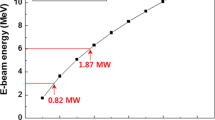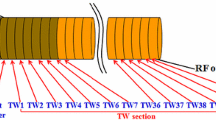Abstract
The proton beam with energy around 100 MeV has seen wide applications in modern scientific research and in various fields. However, proton sources in China fall short for meeting experimental needs owing to the vast size and expensive traditional proton accelerators. The Institute of Nuclear Science and Technology of Sichuan University proposed to build a 3 GHz side-coupled cavity linac (SCL) for re-accelerating a 26 MeV proton beam extracted from a CS-30 cyclotron to 120 MeV. We carried out investigations into several vital factors of S-band SCL for proton acceleration, such as optimization of SCL cavity geometry, end cell tuning, and bridge coupler design. Results demonstrated that the effective shunt impedance per unit length ranged from 22.5 to 59.8 MΩ/m throughout the acceleration process, and the acceleration gradient changed from 11.5 to 15.7 MV/m when the maximum surface electric field was equivalent to Kilpatrick electric field. We obtained equivalent circuit parameters of the biperiodic structures and applied them to the end cell tuning; results of the theoretical analysis agreed well with the 3D simulation. We designed and optimized a bridge coupler based on the previously obtained biperiodic structure parameters, and the field distribution un-uniformness was < 1.5% for a two-tank module. The radio frequency power distribution system of the linac was obtained based on the preliminary beam dynamics design.













Similar content being viewed by others
References
D.I. Thwaites, J.B. Tuohy, Back to the future: the history and development of the clinical linear accelerator. Phys. Med. Biol. 51(13), 343–362 (2006). https://doi.org/10.1088/0031-9155/51/13/R20
Samy Hanna, RF linear accelerators for medical and industrial applications (Boston/London, Artech House, 2012), pp. 1–10
T. Wangler, RF Linear Accelerators (Wiley, New York, 1998), pp. 2–30
U. Amaldi, S. Braccini, P. Puggioni, High frequency linacs for hadrontherapy. Rev. Accel. Sci. Tech. 02(01), 111–131 (2009). https://doi.org/10.1142/S179362680900020X
U. Amaldi, P. Berra, K. Crandall et al., LIBO—a linac-booster for protontherapy: construction and tests of a prototype. Nucl. Instrum. Methods Phys. Res. Sect. 521(2–3), 512–529 (2004). https://doi.org/10.1016/j.nima.2003.07.062
S. Benedetti, A. Grudiev, A. Latina, High gradient linac for proton therapy. Phys. Rev. Accel. Beams 20(4), 040101 (2017). https://doi.org/10.1103/PhysRevAccelBeams.20.040101
G.Y. Jiang, S.Q. Tan, H. Zhao et al., Dynamic power supply controls in Shanghai proton therapy facility. Nucl. Tech. 41(02), 020404 (2018). https://doi.org/10.11889/j.0253-3219.2018.hjs.41.020404. (in Chinese)
Y.Q. Cai, Q.X. Yang, K.Z. Ding et al., Use of radiochromic film for diagnosis of accelerator beam position. Nucl. Tech. 42(01), 010202 (2019). https://doi.org/10.11889/j.0253-3219.2019.hjs.42.010202
P. Berra, Design, construction and tests of a 3 GHz proton linac booster (LIBO) for cancer therapy. Wur Wageningen Ur. 2010(5), 401–408 (2009). https://doi.org/10.1016/0164-1212(88)90031-3
U. Amaldi, B. Szeless, M. Vretenar, et al., LIBO: a 3 GHz Proton Linac Booster of 200 MeV for Cancer Treatment. Paper Presented at the XIX International Linear Accelerator Conference, Chicago, USA, 23–28 August 1998
R.W. Hamm, K.R. Crandall, J.M. Potter, Preliminary design of a dedicated proton therapy linac. Paper Presented at the Particle Accelerator Conference, San Francisco, USA 6–9 May 1991
N. Liu, Y.Y. Yang, J.N. ** et al., Preparation of radioactive isotopes by CS-30 cyclotron and their application. J. Isot. 25(03), 189–192 (2012). https://doi.org/10.7538/tws.2012.25.03.0189. (in Chinese)
P.M. Lapostolle, A.L. Septier, Linear Accelerators (Elsevier, New York, 1970), pp. 1148–1156
S. Kulinski, J. Sekutowicz, Five parameter method of tuning of biperiodic π/2 accelerating structures. Paper Presented at the European Particle Accelerator Conference, Stockholm, Sweden, 22–26 June 1998
R. Wegner, F. Gerigk, A comparison of pi/2-mode standing wave structures for Linac4. (Accelerators and Storage Rings, 2007), http://cds.cern.ch/record-restricted/1005812/?ln=hr;2019. Accessed 15 June 2019
LAACG, Superfish Code. (Los Alamos Accelerator Code Group, 2003). https://laacg.lanl.gov/laacg/services/download_sf.phtml;2019. Accessed 18 June 2019
P. Puggioni, Dissertation, Universita degli Studi di `Milano-Bicocca at Milano Italy, 2008
E.A. Knapp, B.C. Knapp, J.M. Potter, Standing wave high energy linear accelerator structures. Rev. Sci. Instrum. 39(7), 979–991 (1968). https://doi.org/10.1063/1.1683583
D.E. Nagle, E.A. Knapp, B.C. Knapp, Coupled resonator model for standing wave accelerator tanks. Rev. Sci. Instrum. 38(11), 1583–1587 (1967). https://doi.org/10.1063/1.1720608
R. Krishnan, S.N. Pethe, R. Roy, O. Shanker, Analysis of side coupled standing wave linear accelerator structure by the perturbation method. IEEE Trans. Nucl. Sci. 40(5), 1333–1336 (1993). https://doi.org/10.1063/1.1683583
O. Shanker, Generalization of linac mode spectrum and fitting procedure. Rev. Sci. Instrum. 63(10), 4443–4445 (1998). https://doi.org/10.1063/1.1143694
L. Dario, F.M. Christian, B. Michele et al., Electromagnetic design of microwave cavities for side-coupled linear accelerators: a hybrid numerical/analytical approach. IEEE Trans. Nucl. Sci. 1(1), 2233–2239 (2018). https://doi.org/10.1109/TNS.2018.2851387
R.W. de Leeuw, J.E. Coppens, W.J.G.M. Kleeven, et al., Design study for the accelerating cavity of the Racetrack Microtron Eindhoven. Paper Presented at the 4th European Particle Accelerator Conference, London, UK, 27 June–1 July 1994
Z. Chen, Finite element analysis and frequency shift studies for the bridge coupler of the coupled cavity linear accelerator of the spallation neutron source. Paper Presented at the Eighth European Particle Accelerator Conference, La Villette, Paris, 3–7 June 2002
P. T. Greninger et al, Bridge coupler for APT. Paper Presented at the Proceedings of the 2000 International Linac Conference, Monterey, CA, USA, 21–25 August 2000
L.B. Liu, C.L. Li, P.Y. Yu et al., Development of RF superconducting cavity forward power coupler. Nucl. Tech. 42(2), 020201 (2019). https://doi.org/10.11889/j.0253-3219.2019.hjs.42.020201
Author information
Authors and Affiliations
Corresponding author
Additional information
This work was supported by the National Natural Science Foundation of China (Nos. 11375122 and 11875197).
Rights and permissions
About this article
Cite this article
Li, HY., Wan, XM., Chen, W. et al. Optimization of the S-band side-coupled cavities for proton acceleration. NUCL SCI TECH 31, 23 (2020). https://doi.org/10.1007/s41365-020-0735-7
Received:
Revised:
Accepted:
Published:
DOI: https://doi.org/10.1007/s41365-020-0735-7




